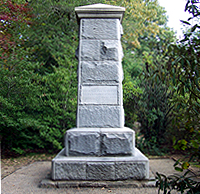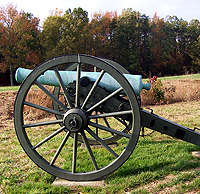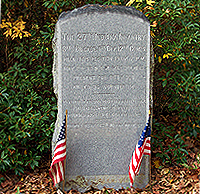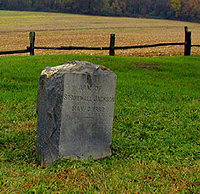|
|
Field Trip #3: Chancellorsville
Battlefield
Photos by Michael Aubrecht (10/06)
Information source: NPS
|
MENU
PAGE
|
The Battle of
Chancellorsville was a major
engagement of the American Civil War fought from
April 30 to May 6, 1863. Referred to as General
Robert E. Lee's "perfect battle," due to his risky
but successful division of his army in the presence
of a much larger enemy force, the battle pitted
Union Army Major General Joseph Hooker's Army of
the Potomac against an army half its size, Lee's
Confederate Army of Northern Virginia. Lee's
audacity and Hooker's timid performance in combat
combined to result in a significant and
embarrassing Union defeat. The Confederate victory
was tempered by the mortal wounding of General
Stonewall Jackson, a loss that Lee likened to
"losing my right arm." The Battle of
Chancellorsville, along with the May, 1864, Battle
of the Wilderness fought nearby, formed the basis
for Stephen Crane's 1895 novel The Red Badge of
Courage For more information, visit NPS Fredericksburg.
|

|
Chancellorsville
Battlefield
The Chancellorsville
campaign began with the crossing of the
Rappahannock River by the Union army in
late April of 1863. Heavy fighting began
on May 1 and did not end until the Union
forces retreated on the night of May 5 to
May 6. A noteworthy characteristic of the
battle was the horrifying conditions under
which it was fought. Soldiers tended to
get lost in the impenetrable maze of
undergrowth and many fires started during
the course of the battle. Grisly reports
of wounded men being burned alive were
common.
|
|

|
Old Mountain Road
This is the road on which
General Thomas "Stonewall" Jackson was
riding when he was injured by friendly
fire. Accompanied by aides and couriers,
the general scouted in front of his main
line, hoping to determine the new Union
position. Members of the 18th North
Carolina believed that the returning
Confederates were Union cavalrymen
charging their line, and carelessly fired
into the darkness. One bullet lodged in
Jackson's right palm and two struck his
left arm.
|
|

|
"Stonewall" Jackson
Rock
In the midst of his great
victory Confederate commander Robert E.
Lee suffered an irreparable loss. On the
night of May 2, 1863, his dynamic
subordinate "Stonewall" Jackson was
mortally wounded by friendly fire. Several
markers commemorate Jackson at
Chancellorsville. The first was the
unmarked quartz Jackson Rock, which was
placed sometime between 1876 and 1883 by
Reverend Beverly Tucker Lacy and James
Power Smith, who had both served on the
general's staff.
|
|

|
Jackson
Monument
In 1888 the Jackson
Monument Association erected this granite
pillar as a testament to the spot where
Jackson fell. Several noteworthy
inscriptions cover the marker's four sides
including two quotes. The first recalls
the legendary statement by Gen. Bernard
Bee at the First Battle of Manassas in
which he said "There is Jackson standing
like a stone wall." On the opposite side,
Jackson's last words of "Let us cross over
the river, and rest under the shade of the
trees" are forever memorialized.
|
|

|
Confederate
Artillery
The forests and landscape
around Chancellorsville, known as the
Wilderness of Spotsylvania and
characterized by dense woods, offered few
opportunities for the use of artillery.
The Southern forces quickly realized that
this open ground was well suited for
cannon. Shortly after Stuart's seizure of
Hazel Grove, Rebel guns crowned this hill.
They targeted the Yankee cannon at
Fairview and the supporting infantry in
the woods on either side of the
clearing.
|
|

|
Hazel Grove
This hill formed
approximately one-fourth of a large open
field on a tract of land called Hazel
Grove. In the pre-dawn hours of May 3,
Union chieftain Joseph Hooker unwisely
ordered his forces positioned here to
abandon Hazel Grove. Jackson's attacks the
previous evening had played havoc with
Hooker's deployment, and the commander
wished to adjust his lines. He instructed
his men to fall back closer to the Union
artillery at Fairview, which was located
across the field.
|
|

|
Union Guns at
Fairview
Acting-commander Gen. JEB
Stuart immediately exploited the
opportunity handed to him by the Federal
abandonment of the open ground by placing
31 cannon on Hazel Grove. Combined with
artillery located west along the Turnpike,
the gunners at Hazel Grove pounded
Fairview with a spectacular bombardment.
The Federals responded with 34 pieces of
their own. The see-saw fighting began to
favor the Southerners as, one by one,
Union artillery pieces dropped out of the
contest. Hooker himself was knocked
momentarily unconscious.
|
|

|
27th Indiana
Monument
This modest stone monument
stands between two smaller flank markers
indicating the front occupied by the 27th
Indiana, one of more than 200 Federal
regiments present for duty on the
Chancellorsville battlefield. An average
regiment, 430 strong, could form a pair of
lines, each line two men deep, in the
space between these flank markers.
Colorful Col. Silas Colgrove led the 27th.
At a hot point during the battle he
shouted to the regiments major, his son,
"Here boy, you run the regiment while I
run this here gun!"
|
|

|
General Paxton
Monument
Gen. Paxton knew on the
night of May 2 that he would die the next
morning. He calmly expressed the
unshakable premonition to his staff, told
them where to find important papers in his
desk, and asked that someone write to his
wife. As the brigade prepared to join the
dawn attack the next morning, he peered
myopically at his pocket Bible in the dim
light. Just as the advance started, a
bullet hit the general in the chest. An
aide by his side put an arm under the
wounded man to lift him, but within
moments Frank Paxton was dead.
|
|

|
Chancellor Inn
Ruins
From May 1-3, 1863, this
house served as headquarters for Union
Gen. Joseph Hooker and as a hospital
during the Battle of Chancellorsville.
Frances Chancellor, her children and a few
other local people remain sheltered in the
house while the battle raged around them.
During the melee, Gen. Hooker was knocked
to the ground and rendered briefly
unconscious when a porch column against
which he was leaning was split in half by
a shell. With the house in flames,
Confederate forces converged on the
clearing from three directions as the
retreating Federals streamed
northward.
|
|

|
Catherine Furnace
Ruins
Here are the ruins of the
Catherine Furnace which the Confederates
had used to aid in the manufacture of much
needed weaponry. Prior to the battle,
General's Lee and Jackson had decided upon
a daring plan, a gamble that Jackson could
get around the Union flank without the
Federals attacking and crushing the much
smaller Southern force which remained in
their front. Despite an attack by Union
Brig. Gen. David Birney, the column
proceeded on their march past this
furnace, led by the son of Charles
Wellford, the furnace's owner, in lines
4-men wide and nearly 10-miles long.
|
|

|
Ellwood Manor
After being severely
wounded at the Battle of Chancellorsville
on the evening of May 2, 1863, Gen.
Jackson was transported to the field
hospital near the Wilderness Tavern. Dr.
Hunter McGuire saved Jackson's life by
stopping the bleeding and later in the
night amputated Stonewall's left arm.
Reverend Beverly Tucker Lacy, chaplain of
Jackson's Corps, buried the arm in the
Lacy family cemetery at Ellwood. In 1903 a
monument was put in the cemetery by James
Power Smith, a member of Jackson's staff
and son-in-law of James Horace Lacy.
|
|
|
|